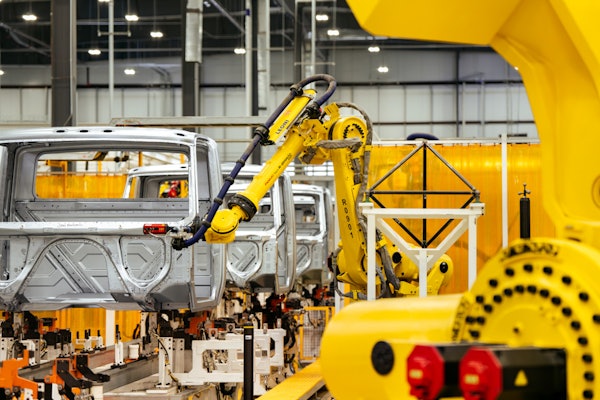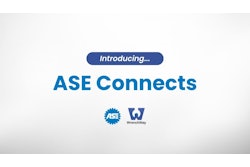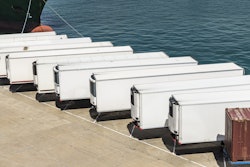Recognize, Prevent Corrosion and Rust Jacking
When rust creeps in between the brake lining and shoe table, it can cause the lining to fracture, according to ArvinMeritor.
During normal braking, a brake lining will have miniscule movement from temperature cycling, brake torque and component deflections, relative to the shoe table. If the lining wears off the paint on the shoe table (a condition called micro-abrasion), the bare metal is exposed to road spray and grime. At that point, oxidation can begin to form as quickly as overnight.
Over the long term, layers of rust can build up between the brake shoe and the lining. Each layer puts more upward pressure on the lining, which is firmly riveted to the shoe. Eventually, the lining can crack.
Rust jacking looks different from surface cracks, edge de-lamination or fractures that happen when the lining is worn down to the rivet head.
The characteristics of rust-jacked shoes include:
- There’s still plenty of usable lining on the shoe, at least 1⁄8 inch above the rivet heads.
- The lining is buckling between the rivet heads, resulting in a noticeable gap between the shoe table and lining block.
- Cracks tend to run horizontally across the lining and are visible along the edge of the lining block. The lining also may be flaking, chipping or show other signs of deterioration.
Rust happens when iron and oxygen react, usually in the presence of water. Rust jacking, therefore, is more likely to occur when moisture can collect between the brake shoe and lining. - The amount of brake heat that can reach the shoe table (higher temperatures speed up the evaporation of moisture). Shoes with thicker linings help insulate the shoe table from whatever brake heat is generated.
- The duty cycle of the vehicle and the replacement rate of the shoes. Shoes that receive little work or are left on the vehicle for several years are more susceptible to rust jacking.
- The quality of the brake-shoe table paint process and its ability to resist micro-abrasion.
- Exposure to seawater or winter-road deicers like salt and chemical compounds like magnesium chloride, calcium chloride or sodium chloride which can accelerate corrosion of bare metal.
Several factors influence this, including:
Paint is the brake shoe’s most basic level of protection from oxidation, according to ArvinMeritor.
Specifying a high-quality OE or remanufactured brake shoe is the first thing you can do to reduce the risk of rust jacking, according to ArvinMeritor, and staying ahead of corrosion demands every-day diligence.
Advise your customers to spray the vehicle’s undercarriage to wash away salt and road grime on a regular basis. Use a gentle stream from a hose, not a pressure washer.
When a truck or trailer is brought in for service, inspect the linings for abnormal wear and potential out-of-service conditions: cracks or voids more than 1⁄16 of an inch wide; cracks that exceed 1-1⁄2 inches in length; cracks across the lining face that extend through the lining edges; and cracks that result in missing chunks of lining. Any of these conditions may indicate rust jacking.
Finally, specify replacements that match the quality, performance and wear characteristics of the original. If the vocation of your customer’s truck has changed, select linings that will deliver the necessary performance for his new speeds, braking pressures, loads and operating conditions.
Coolant Leakage At Thermostat Housing
If you discover a coolant leak at the thermostat housing on a vehicle equipped with a Mack MP8 engine, use the revised housing seal (Part No. 21298915) having a shorter locating tab.
The shorter locating tab prevents coolant from “weeping” past the seal at the locating slot of the housing.
Two Tips for Troubleshooting Poor Heater Performance
Spring is a busy time for A/C tune-ups, but it’s also a good time to ask about the heater, according to Red Dot. Here are two simple troubleshooting tips to put at the start of your diagnostic process:
1. Wireless Ground Connections – A bad ground connection can rob the blower motor of the voltage it needs. Some motors don’t have a ground wire and depend on their mount for a good ground connection. If the mount’s ground path is somehow interrupted, then the blower motor won’t be grounded, either. Use a multimeter to make sure you’re getting full voltage to the motor. Once you know the voltage is adequate, you can then look for worn brushes, dirty squirrel-cage fans, damaged fan blades and other more typical motor problems.
2. Deteriorating Hoses – A large amount of debris can accumulate in coolant over time. Some contaminants are big enough to plug water valves and potentially damage the heater core. Much of this debris comes from hoses, which deteriorate from the inside out and shed material into the coolant. That’s why it’s important to promote coolant changes at recommended intervals – and to replace hoses that feel spongy.
Red Dot offers one final note about heater components: always match replacement parts to the original spec. If the truck uses a long-life motor, the replacement should be a long-life motor. Long-life motors are rated from 6,000 to 12,000 hours of service life. Standard motors – with their sleeve bearings and shorter brushes – are rated at 4,000 hours.
Automatic Transmission Oil Cooler Supply Pipe
Effective February 20, 2009, Mack implemented a revised coupling hose (Part No. 21317104) for Allison automatic transmission oil cooler supply pipe-to-thermostat housing connection on MRU and LEU model chassis.
The revised coupling hose has a smaller inside diameter to prevent hose disengagement. If you find coupling hose disengagement, it is recommended that the existing hose be replaced with the revised hose. Part No. 21317104 (transmission oil supply pipe coupling hose) replaces Part No. 20876753. Hose clamp Part No. 20705903 replaces Part No. 560AM9.
Power Steering Pumps With Metric Fittings
Service replacement power steering pumps for Mack MP7 and MP8 engines use metric threads at the high pressure and suction ports.
If you need to replace an existing power steering pump on a CXP or CTP model chassis, the existing straight-thread fittings must be replaced with metric fittings.
Cam Roller Lubrication
The proper way to lubricate a cam roller is directly in the web roller pocket and not on the cam-to-roller contact area, according to ArvinMeritor, Inc. If you do this correctly, you will avoid creating flat spots. These flat spots adversely affect the brake adjustment, which may result in premature brake wear or reduced braking performance. The best time to change cam rollers is at a brake reline.







